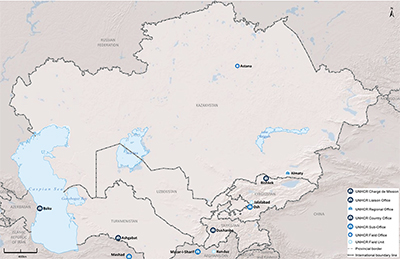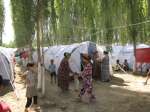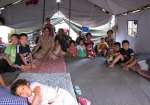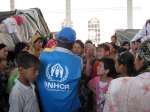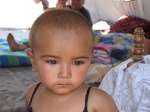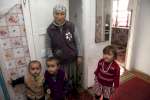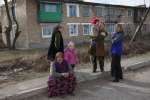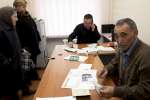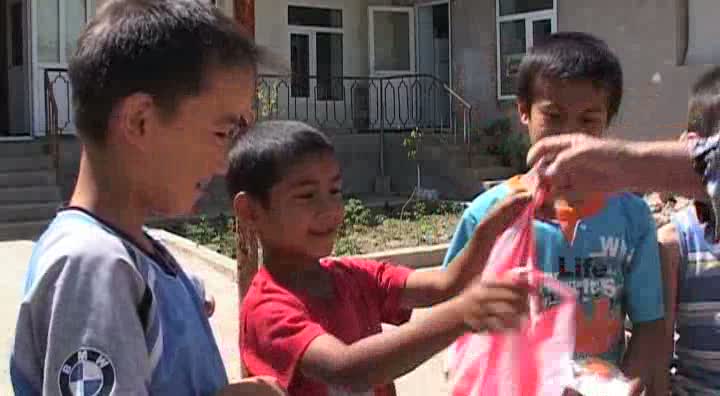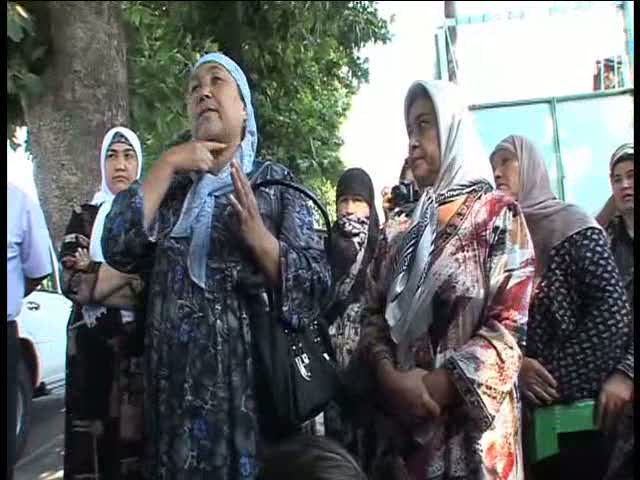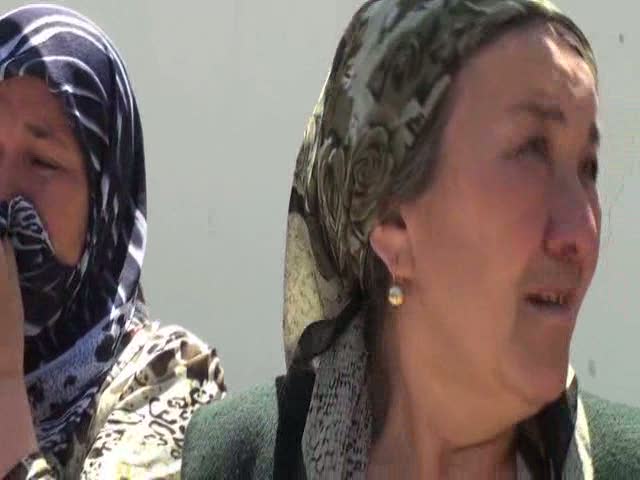Home > Where We Work > Asia and the Pacific > Central Asia > Kyrgyzstan
2015 UNHCR subregional operations profile - Central Asia
| Overview |
In Central Asia, UNHCR's work focuses on developing national asylum systems, seeking solutions for refugees and stateless people and supporting the implementation of emergency preparedness measures.
National refugee legislation in the subregion is inconsistent with international standards. States are preoccupied with cross-border/transnational threats and national security, which impacts asylum policy and the protection of refugees. Progress in political reforms and developments are prerequisites for a favourable protection environment and sustainable solutions for those of concern to UNHCR.
Improving national asylum systems involves ensuring that access to territory, improved reception conditions and refugee status determination (RSD) procedures meet international standards. To advocate for this, regional platforms for refugee protection and international migration, such as the Almaty Process, are used.
Voluntary repatriation is facilitated on a case-by-case basis; however, interest in returning to an uncertain future in Afghanistan has been limited in 2014. Resettlement can help maximize protection dividends in the subregion and address the protracted nature of the Afghan refugee situation, alongside efforts to advocate for alternative stay arrangements, and pursue local integration.
While in 2015 the socio-political environment is not expected to change dramatically, UNHCR does not exclude the possibility of mixed migratory movements from Afghanistan and within the subregion. In relation to this, individual countries are expected to raise national security concerns about asylum and migration, influencing policies. The Office will continue to cooperate with government ministries in Central Asia and partner agencies on overall emergency preparedness, in particular for a possible influx of refugees from Afghanistan.
The UNHCR Seeds for Solutions initiatives in Kazakhstan, Kyrgyzstan and Tajikistan in 2014 have been designed to target ending statelessness within the next decade.
Turkmenistan is the first and only country in Central Asia to accede to both the 1954 and 1961 UN Statelessness Conventions. UNHCR continues to advocate residence permits for mandate refugees who are not eligible for naturalization, and pursues resettlement for a small number of Afghan refugees. In July 2014, the Government introduced identification and travel documents for refugees and stateless people, which are compliant with the standards of the International Civil Aviation Organization (ICAO) and will be issued free of charge for refugees.
In Kyrgyzstan, UNHCR is implementing programmes as part of a UN-wide peacebuilding plan funded by the Peacebuilding and Recovery Facility of the UN Peacebuilding Fund. Projects focus on sustainable reintegration of those affected by inter-ethnic clashes in June 2010. Activities include trust- and confidence-building measures between individuals, communities and authorities. In addition, Kyrgyzstan is a pilot country of the Secretary-General's Policy Committee Decision on Durable Solutions. UNHCR, together with the UN Country Team in Kyrgyzstan, is providing the strategic framework for its successful implementation.
In light of the volatile security situation in the Fergana Valley, a joint contingency plan was drafted and endorsed by the Kyrgyz Government in 2013. Several activities, such as joint simulation and high-level working group meetings, have enhanced emergency preparedness for any mass refugee influx from neighbouring countries.
In Kazakhstan, the Government has been responsible for RSD since 2010, but UNHCR continues to cooperate with government agencies dealing with asylum. Kazakhstan hosts approximately 600 refugees and asylum-seekers, and around 7,000 officially-registered stateless people. In 2014, UNHCR, together with the Government, has initiated an information campaign to identify and register stateless people and find solutions to their situation.
Tajikistan hosts approximately 4,000 asylum-seekers and refugees (97 per cent are of Afghan origin), the largest refugee population in Central Asia. The country faces a range of socio-economic challenges affecting both Tajik nationals and refugees. Refugees do not have the freedom to establish their place of residence, and are banned from living in major cities. The asylum system is fragile and the quality of RSD is insufficient. The statelessness of thousands remains a challenge. UNHCR is reinforcing its efforts to address statelessness issues, and promote inter-agency partnerships to enhance emergency preparedness.
The Office has not been present in Uzbekistan since 2006. Nonetheless, it caters for a small number of refugees (133 people), predominantly of Afghan origin, through a project with UNDP aimed at finding solutions for them, including improved stay arrangements and resettlement. Uzbekistan hosts a significant stateless population. The country is not a party to the 1951 Convention relating to the Status of Refugees, nor to either of the two Statelessness Conventions.
| Response and implementation |
In Kazakhstan, legislative improvements are required in various laws and administrative procedures to ensure the asylum system functions properly. UNHCR continues to advise on national legislation and share good practice for refugee protection. Advocacy and support efforts continue with a view to the country's accession to the UN Statelessness Conventions and the reduction of statelessness. Contingency planning and emergency preparedness will remain UNHCR priorities.
In Tajikistan, the Office will work closely with the Government and other partners to identify and achieve solutions for stateless people. It will reinforce its inter-agency preparedness work, considering potential displacement scenarios, including in relation to the Afghanistan situation. UNHCR will continue to promote access to asylum and ways to safeguard border management systems, as Tajikistan is located at the crossroads of complex subregional population movements, including human smuggling and trafficking, which often originate in Afghanistan. The organization will support the strengthening of national asylum systems, while ensuring sufficient capacity to address any gaps in mandate RSD.
Priorities for UNHCR in Turkmenistan include: engaging the Government in procedures for receiving asylum-seekers and processing asylum claims, as well as continuing to assist relevant government structures in finding durable solutions for stateless people registered in 2011. In 2015, UNHCR will continue to seek durable solutions through naturalization and resettlement. It will assist the Government in developing and implementing a statelessness status determination procedure. Government partners will receive assistance to develop their refugee emergency preparedness and response capacity.
In Kyrgyzstan, the Office will continue to work towards ending statelessness. Innovative programmes funded by the UNHCR Seeds for Solutions initiative are being implemented with government partners and local NGOs. The activities include on-the-spot registration of undocumented and stateless people by multifunctional mobile teams.
Strategic priorities include: building a comprehensive protection system and providing durable solutions for individual beneficiaries, as well as improving the quality of state registration and RSD. The reintegration strategy entails improved dialogue between the Government and communities, impartial and timely analysis of problematic areas, and collaborative problem solving. It is anticipated that the activities designed as part of the peacebuilding project will be successfully implemented, enabling UNHCR to close its offices in the south by the end of 2015.
In Uzbekistan, provision of services to refugees will continue through the UNDP project aiming at finding solutions. Advocacy efforts to improve stay arrangements and other solutions for refugees will continue with the Government.
| Financial information |
The budget for Central Asia has gradually decreased from USD 33.3 million in 2010, reflecting the activities initiated after the conflict in Kyrgyzstan in 2010, to USD 16.7 million in 2014. For 2015, the subregional budget stands at USD 14.7 million.
UNHCR in Central Asia maintains contingency plans for possible population movements from Afghanistan in the event of any political or social instability. Should there be any significant refugee influxes from Afghanistan to Central Asia, the mobilization of additional funding would be required.
| UNHCR 2015 budgets for Central Asia (USD) | |||||
|---|---|---|---|---|---|
| Operation | 2014 Revised budget (as of 30 June 2014) |
2015 | |||
| Refugee programme PILLAR 1 |
Stateless programme PILLAR 2 |
IDP projects PILLAR 4 |
Total | ||
| Total | 16,680,100 | 9,052,161 | 3,959,898 | 1,657,546 | 14,669,605 |
| 1. Includes activities in Uzbekistan. | |||||
| Kazakhstan Regional Office[1] | 7,428,386 | 4,742,400 | 2,526,919 | 0 | 7,269,319 |
| Kyrgyzstan | 6,298,968 | 1,857,413 | 747,425 | 1,657,546 | 4,262,384 |
| Tajikistan | 2,093,364 | 2,180,013 | 263,265 | 0 | 2,443,279 |
| Turkmenistan | 859,383 | 272,335 | 422,289 | 0 | 694,624 |
Source: UNHCR Global Appeal 2015 Update

